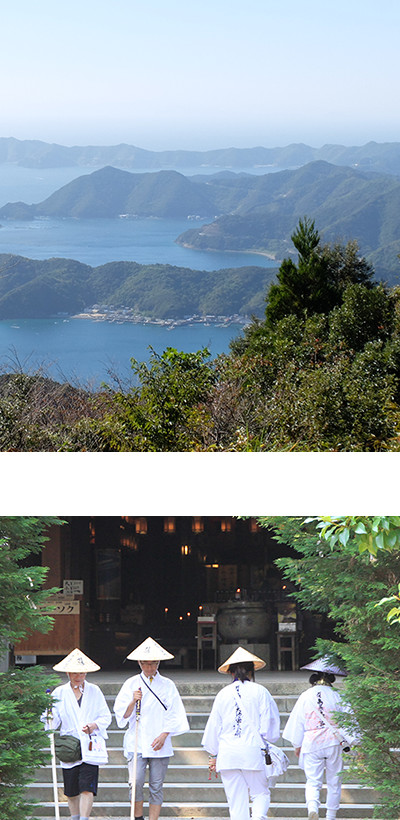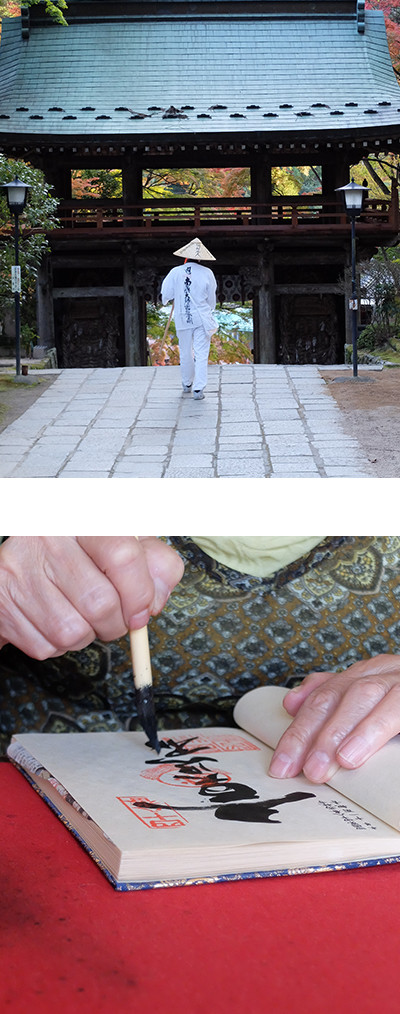Follow the footsteps of Kobo Daishi, and feel your heart grow through the magnificent sacred pilgrimage.

The origin of the Shikoku Henro is 1200 years ago.
Sacred Pilgrimage it is said, started when monks and ascetics followed the routes of Kukai (Kobo Daishi) - where he was born, trained and was enlightened.
The Shikoku Henro is a 1,400 km grand circular Henro route of 88 temples that was established by the great Buddhist priest, Kukai (Kobo Daishi), across the entire Shikoku regions of Awa (Tokushima Prefecture), Tosa (Kochi Prefecture), Iyo (Ehime Prefecture) and Sanuki (Kagawa Prefecture).
With the changes in times from the Heian Period to the Edo Period developing the traffic, pilgrimage to remote locations became active and along with the spread of the Kobo Daishi faith, pilgrimage also spread to the common people.
Even though pilgrimage now can be conducted using bus, train and private cars, many people still do the pilgrimage on their own feet.
The location they depart from, are from many places.
What they desire from their pilgrimage is also varied.
This long distance "migratory" circular type of pilgrimage in Shikoku is different from those practiced under Christianity or Islam which often focus on the voyage to and return from a holy place.
Awa, the beginning of the pilgrimage is "dojo (training hall) of awakening", Tosa is where one confronts oneself in "dojo of asceticism", Iyo is where one is freed from doubt in "dojo of Bodhisattva" and Sanuki is where one is fulfilled and is enlightened in "dojo of Nirvana".
If you walk around all the Fudasho (temple issuing amulets), it will be a long trip taking 40 days or more. It is not necessary to go to all the Fudasho at once, and one can divide them into installments "Kugiriuchi" like "10 kasho mairi" (10 locations worship) or "Ikkoku mairi" (1 country worship) where you separate the pilgrimage by each country of Awa, Tosa, Iyo and Sanuki, or "Midareuchi" (random attack) where you do not do the pilgrimage in their order. As shown, the way to do the pilgrimage varies from one person to the next, and there are many people who have done the pilgrimage many times.
The "Journey of the heart" going beyond nationality, religion and generations.

Shikoku Henro is where everyone becomes a pilgrim regardless of their nationality, religion/sect, and circulates the road together with Kobo Daishi as "Dogyoninin" (two people together).
With thoughts such as "salvation", "healing", "memorial" and "training" in your heart, time to contemplate about yourself flows as you take one step at a time to the next Fudasho.
In Shikoku, from ancient times, there is a culture to warmly accept and watch out for the pilgrims as a familiar presence.
This region's unique assistance is referred to as "Osettai" (entertainment), and offers meals, fruits and beverage as well as words of appreciation, shows the direction to go, and may also provide "Zenkonyado", free accommodation and baths.
The Osettai also is said to be "by performing Osettai to pilgrims, one will have the pilgrim do the pilgrimage on one's behalf" or "the Osettai itself is a merit".
These mingling with the local residents and their casual words will inspire a new felling of vitality so that the pilgrims can continue on with their pilgrimage.
Shikoku Henro is the "Faith" towards Kobo Daishi, and the "Place" in which to perform the training, the "region" which support these, integrated into one; a pilgrimage culture that is unparalleled in the world, and is a living cultural heritage that passes on the spirit, history and culture of the Japanese people.

